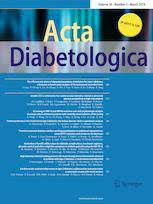Patterns of changes in fasting plasma glucose, hemoglobin A1c and the area under the curve during oral glucose tolerance tests in prediabetic subjects: results from a 16-year prospective cohort study among first-degree relatives of type 2 diabetic patients
Authors
Affiliations
Abstract
Aim: This study aimed to identify the patterns of changes in glycemic indices over time in prediabetics and to classify these subjects as either having a high or low risk for developing diabetes in future.
Methods: This prospective 16-year cohort study was conducted among 1228 prediabetic subjects. Three measurements including first visit, mean values during the follow-up period, and last visit from fasting plasma glucose (FPG), glycosylated hemoglobin (HbA1C), and area under the curve during an oral glucose tolerance test (OGTT AUC) were used to evaluate the patterns of changes by using the latent Markov model (LMM).
Results: The mean (standard deviation) age of subjects was 44.0 (6.8) years, and 73.6% of them were female. The LMM identified 2 latent states of subjects in terms of changes in FPG, HbA1c, OGTT AUC, and the combination of these glycemic measures: a low tendency to progress diabetes and a high tendency to progress diabetes with the latent state sizes (87, 13%), (94, 6%), (57, 43%), and (84, 16%), respectively. The LMM showed that the probability of transitioning from a low tendency to a high tendency to progress diabetes was higher than the probability of transitioning in the opposite direction.
Conclusion: Based on a long-term evaluation of patterns of changes in glycemic indices, we classified prediabetic subjects into 2 groups (high or low risk to progress diabetes states in future). Also, the method used enabled us to estimate the transition probabilities from low- to high-risk states and vice versa. Our results reemphasized the values of all 3 glycemic measures in clinical settings for identifying prediabetic people with a high risk of progressing diabetes and the need for more effective prevention strategies, which should be conducted as urgently in prediabetic life as high-risk subjects.
Keywords: FPG; Glycemic indices; HbA1c; Latent Markov model; OGTT AUC; Prediabetes; Type 2 diabetes.

